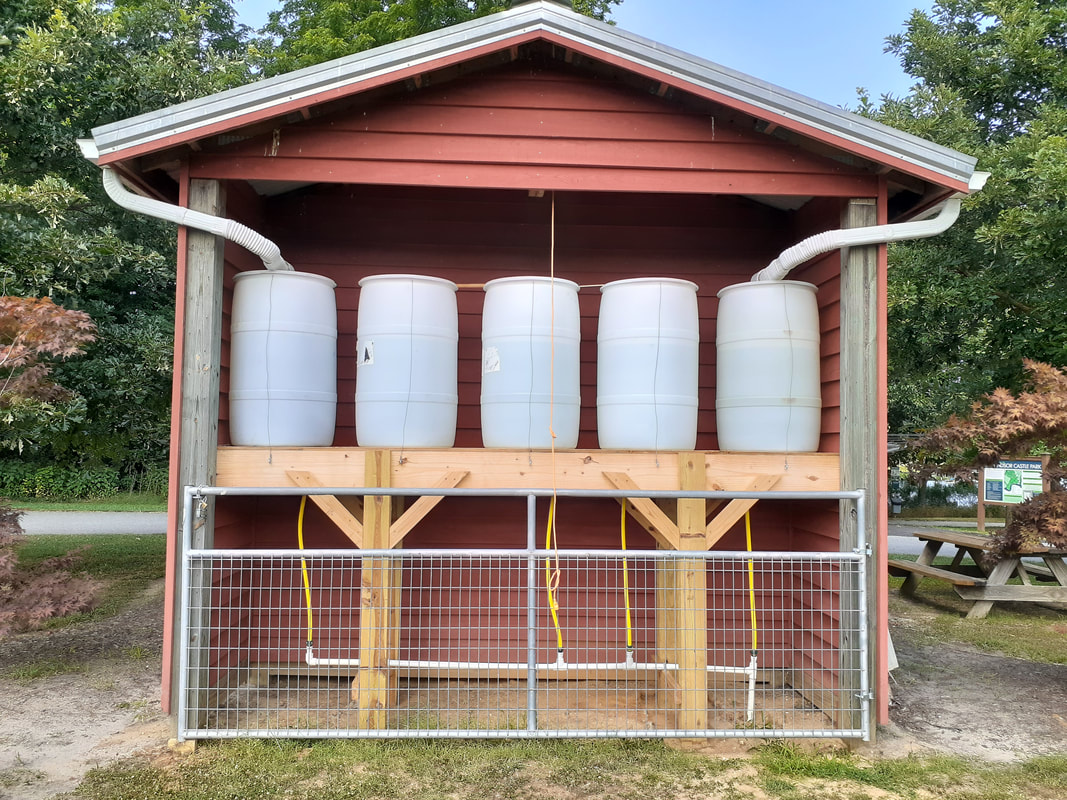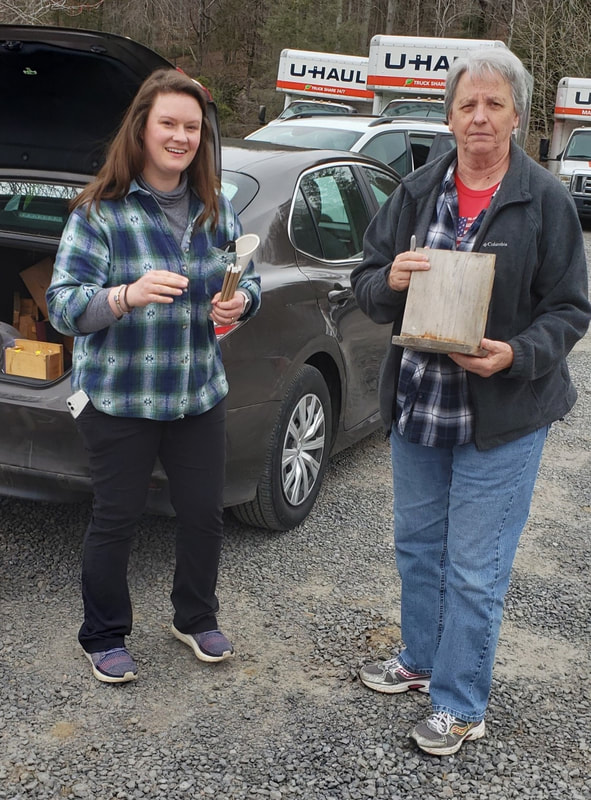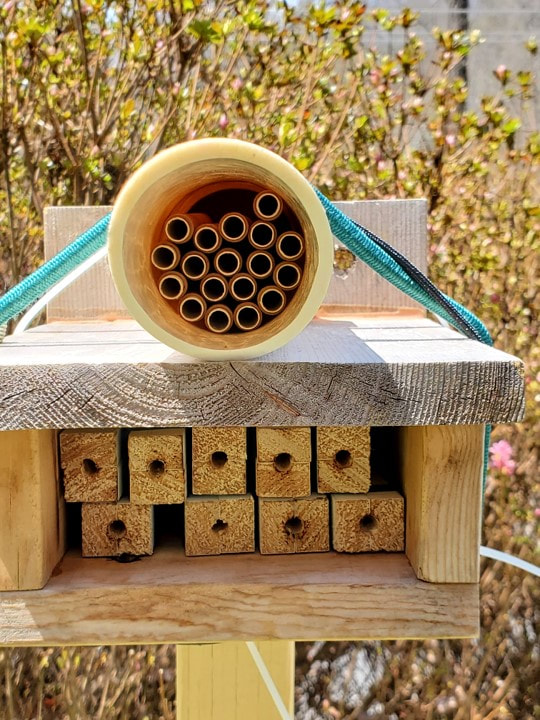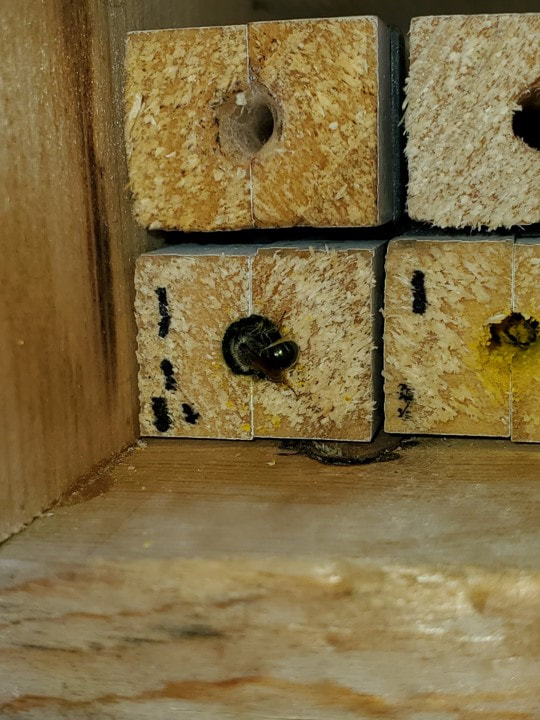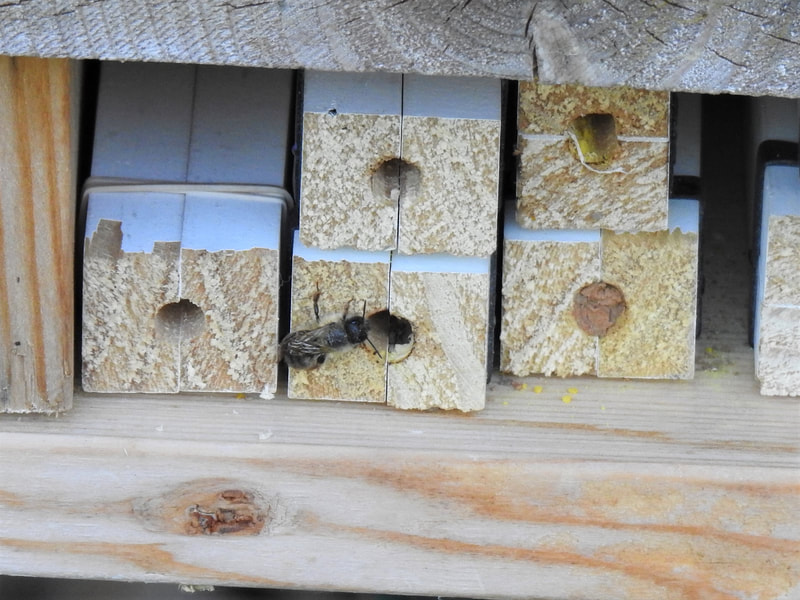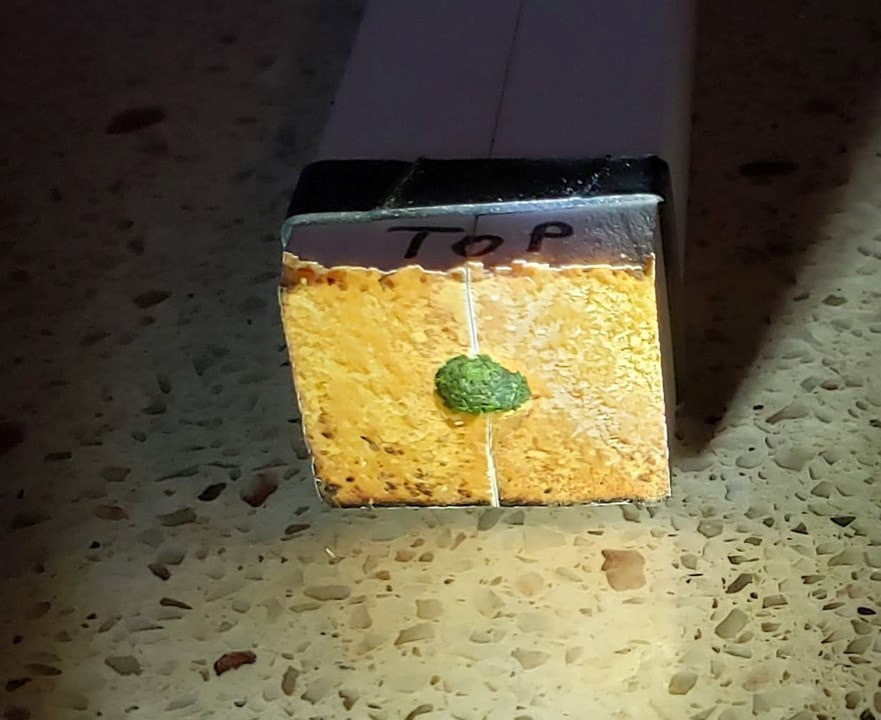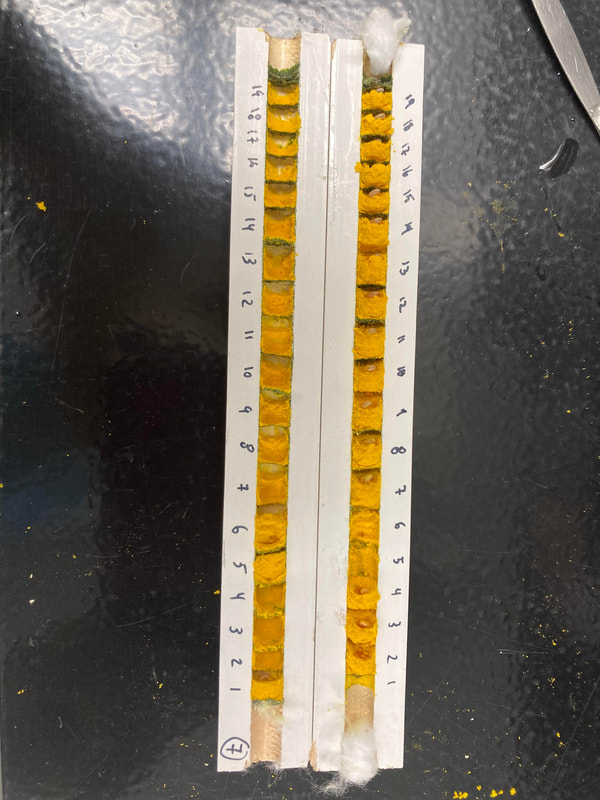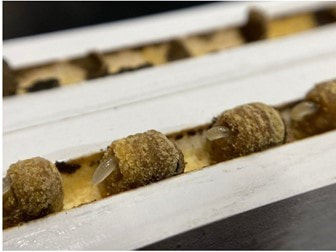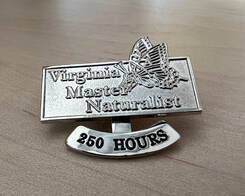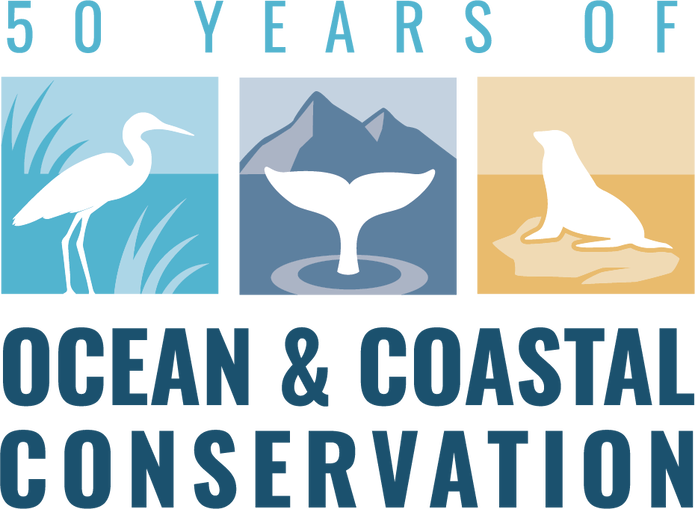Each quarter, we invite VMN chapters to share stories of volunteers’ awards and accomplishments. Our Laurels posts are not only a way to provide recognition to those volunteers, but also an opportunity to inspire other volunteers. If you are inspired by one of the projects or accomplishments mentioned here and want more information, please contact the VMN state office and we’ll put you in touch!
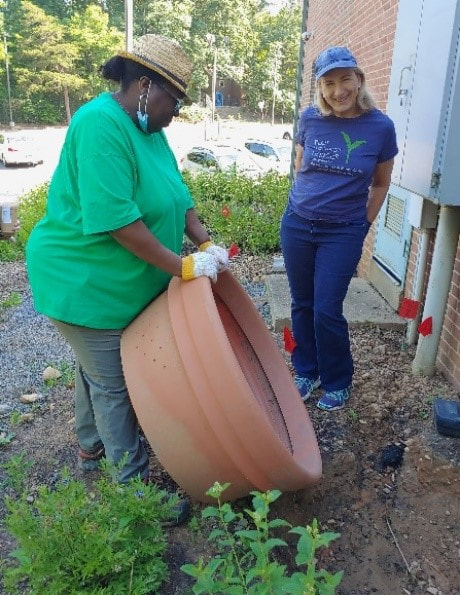 Virginia Master Naturalist volunteer and pollinator garden leader Valerie LaTortue discusses how to increase soil percolation with Arlington County’s Extension Agent and VMN Chapter Advisor Kirsten Conrad (right). Photo by Devin Reese.
Virginia Master Naturalist volunteer and pollinator garden leader Valerie LaTortue discusses how to increase soil percolation with Arlington County’s Extension Agent and VMN Chapter Advisor Kirsten Conrad (right). Photo by Devin Reese.
Bringing New Life to a Pollinator Garden
–Adapted from post by Devin Reese on the Arlington Regional Master Naturalist blog with additional contributions from Kasha Helget
Virginia Master Naturalist volunteer Valerie LaTortue is a magnet for other volunteers. She is also an active Extension Master Gardener, and she has used her skills from both programs to organize a volunteer crew to work in the Pollinator Garden at the Jerome Buddie Ford Nature Center in Alexandria. The volunteer crew meets most Saturdays and has removed invasive plants from the garden, added erosion-prevention features, and improved garden access. On a recent Saturday, the task was building a short, curved retaining wall to make a barrier against erosion as well as demarcate a small area for visitors and students to stand while viewing the garden. The volunteer crew included Master Naturalist and Master Gardener volunteers, Valerie’s son, a first-time volunteer tagging along with his Master Naturalist girlfriend, and others–more volunteers than shovels! Explains Valerie, “Today, we are working on a teaching area and rainwater garden. When it rains hard, water pours off the roof, and the flow moves everything downhill.” Valerie expresses her excitement about the project, “Usually the children are up on the deck tripping over each other. When the Nature Center teaches its pollinator class now, they can be inside the garden, not outside and just pointing.”
VMN volunteer Kasha Helget says, “It is such a feel good project. This garden was unfortunately neglected due to understaffing at the Buddie Ford Nature Center. But Valerie took it over and it may become the signature native plant garden for Alexandria. Valerie is incredibly humble and hardworking, but has great vision for the project and what it can mean for the attached park (Dora Kelley Nature Park).”
Read more about this project and the volunteers involved in these blog posts from the Arlington Regional Master Naturalist Chapter:
Stemming Erosion and Shoring Up a Learning Space in the Jerome Buddie Ford Nature Center Pollinator Garden
Revitalizing the Pollinator Garden at the Buddie Ford Nature Center
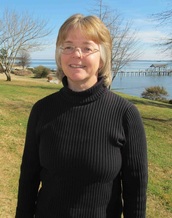 Karen Duhring, VIMS Center for Coastal Resources Management
Karen Duhring, VIMS Center for Coastal Resources Management
VIMS Award for Outstanding Outreach
Karen Duhring, our VMN liaison from the Virginia Institute of Marine Science (VIMS) Center for Coastal Resources Management and the Chapter Advisor of the Middle Peninsula Chapter, received the
VIMS Outstanding Professionals and Professional Faculty Outreach Award. This award recognizes achievement relating to fulfilling the VIMS outreach mission. Karen has been a major contributor to the development of VMN training curriculum on the topic of Coastal and Estuarine Ecology and Management, and she regularly teaches both classroom and field sessions on coastal resources for VMN chapters. She is a strong advocate for the VMN program and has been a critical liaison between the VMN program, VIMS, and other state agency sponsors. We are so thankful to have her on our team and are pleased to see her agency recognizing her with this award!
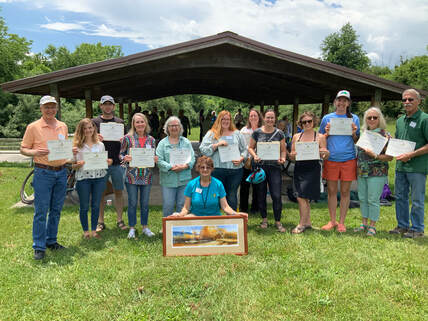 Members of the 2022 graduating VMN basic training course of the New River Valley Chapter with course coordinator Dianna Bridges (front center). Six graduates are not shown. Photo by VMN-New River Valley Chapter.
Members of the 2022 graduating VMN basic training course of the New River Valley Chapter with course coordinator Dianna Bridges (front center). Six graduates are not shown. Photo by VMN-New River Valley Chapter.
A New Crop of VMNs in the New River Valley
–Contributed by Dianna Bridges, Sharon Simón, and Dora Butler
The VMN-New River Valley Chapter recently graduated 19 new students in June 2022 following a four month training program that combined both on-line Zoom classes and in-person classes and field sessions. Members of the New River Valley Chapter have volunteered since 2007 in many local projects including invasive plant removal in Stadium Woods on the Virginia Tech campus, and monitoring bluebird boxes at several Blacksburg schools and the Corporate Research Center. Members have monitored trails at Falls Ridge and Smithfield Plantation, maintained pollinator gardens at Pandapas Pond, SEEDS and Warm Hearth and participated in citizen science projects such as stream monitoring for the Virginia Save Our Streams initiative, wildlife mapping and recording activity in local Vernal Pools.
Dianna Bridges has been the Training Coordinator for the past ten years. She is pictured with the 2022 class at the graduation ceremony where the class presented her with a framed watercolor painting of Sinking Creek.
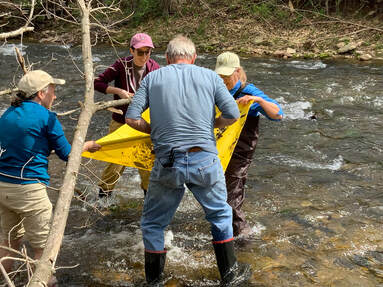 Practicing stream monitoring during the New River Valley Chapter’s basic training course. Photo by Dianna Bridges.
Practicing stream monitoring during the New River Valley Chapter’s basic training course. Photo by Dianna Bridges.
Two of the students, Dora Butler and Sharon Simon also became certified as Izaak Walton League’s Save Our Streams (SOS) monitors at the same time this spring.
Sharon writes, “As a new student in the VMN Class of 2022, I was intrigued about stream assessment after hearing one of the prior graduates enthusiastically speak during the first “in-person” class in January about the Izaak Walton League’s Save Our Streams citizen science programs. As a part of the VMN curriculum, we were required to attend a stream assessment field trip with certified volunteers. This field experience really make me realize that I wanted to be involved with the program. Upon returning home that night, I examined the requirements for certification on the IWLA website which includes stream assessment procedural videos for rocky bottom and muddy bottom samplings, a tutorial on macroinvertebrates, and a link to the macroinvertebate ID test which has to be passed with a score of 90%. Once completed, you must submit an application to attend an assessment field trip with a certified VA SOS instructor. Dora and I worked with Kira Carney, the SOS Coordinator, Mid Atlantic and decided to form our own team!
We have identified two sites to test in the fall and both sites have been approved by the VA SOS coordinator. Kira has been very helpful in getting our stream monitoring permit and we are in the process of gathering equipment and gaining permission from property owners. The IWLA website is very user friendly and does not require a huge time investment. Becoming certified while attending class is helpful because our team is entirely composed of classmates who are enthusiastic about citizen science. Another way to become involved in an activity that requires very little time is the Salt Watch program. The test kits are free and sent by mail at anyone’s request through the IWLA SOS website. Curiosity about your surroundings is what drives one to explore and dig deeper for answers! The VMN program has opened up so many opportunities!”
Dora adds, “The VMN Basic Training provided a broad base of knowledge about our environment that can be used in service as citizen scientists, stewards and advocates for our natural resources. We also received information on ways to access continuing education and volunteer opportunities with organizations working to identify and address risks to our wildlife, forests and water supply. In the early weeks of the class I learned about the Save Our Streams assessment certification program from a classmate. The SOS on-line certification process aligned perfectly with the VMN training. A VMN field trip, led by SOS certified volunteers, provided the hands-on experience I needed to successfully complete the macro ID and assessment procedure exams required for SOS certification. The hours I spent on the SOS training and certification even counted toward continuing education hours required for VMN certification.”
Congratulations to Sharon, Dora, and all the New River Valley graduates, and thank you to Dianna for her coordination of the training!
Fifteen Minutes in the Forest with a VMN Volunteer
The Virginia Forest Landowner Education Program offers a regularly occurring, fun, and educational online program, Fifteen Minutes in the Forest, that uses pre-recorded video to share high-quality information about forests and forest management. In the spring, VMN volunteer Judy McCord was a guest star on the program, sharing information about vernal pool habitats and the pools she monitors at Claytor Lake State Park. View the video below, and check out the whole Fifteen Minutes in the Forest series on YouTube!
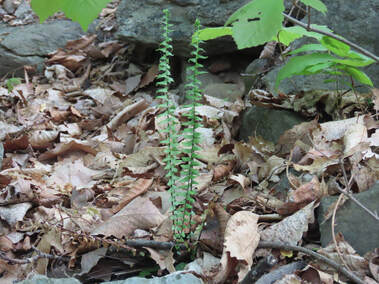 Ebony Spleenwort (Asplenium platyneuron) was one of 168 confirmed species Bruce observed during the City Nature Challenge. Photo by Bruce Slater, CC-BY-NC.
Ebony Spleenwort (Asplenium platyneuron) was one of 168 confirmed species Bruce observed during the City Nature Challenge. Photo by Bruce Slater, CC-BY-NC.
VMN Member Prevails in Charlottesville Region 2022 Nature Challenge Bioblitz
–Contributed by Susan McSwain, VMN-Central Blue Ridge Chapter
In 2016, San Francisco and Los Angeles got into a duel with each other to see which city could record the highest number of wildlife species in a weekend-long bioblitz. Since then, the
City Nature Challenge (CNC) has grown into an international event overseen by the California Academy of Sciences and the Natural History Museum of Los Angeles County. It is now a four-day global bioblitz held every year at the end of April.
In 2022, some 50,000 species were recorded by 67,000 participants from 445 cities in 47 countries. CapeTown, South Africa was the winner with both the highest number of species recorded (close to 5,000!) and the highest number of observations submitted.
Here in Virginia, Charlottesville was a participant in the 2022 CNC, which was sponsored by The Nature Conservancy. The Charlottesville CNC included the surrounding counties of Fluvanna, Greene, Louisa, Nelson, and Albemarle. Bruce Slater, a Master Naturalist in the Central Blue Ridge chapter, outdid all of the other participants in this CNC. Bruce was interviewed about his achievement by fellow CBR member, Susan McSwain.
Susan:
Bruce, where do you live, and what made you decide to join the Nature Challenge?
Bruce:
My wife and I moved to Nellysford in Nelson County almost 4 years ago. The Nature Challenge was a great motivation to set aside time to get outside and look for species.
Susan:
What kind of places did you visit to do your recording, and how many hours do you think you spent making your observations?
Bruce:
I started in our 3.7-acre lot in Stoney Creek and surprised myself at how many species I found around here. There were many that I expected and quite a few new-to-me findings! After that, I availed myself of many miles of trails in Stoney Creek, Rockfish Valley Foundation trails, and trails in Wintergreen on the mountain. I must have spent 10-12 hours wandering around taking pictures.
Susan:
How many species did you record? Were you surprised when you learned that you were the person with the highest number of species? How did you find out?
Bruce:
I made 194 observations over the 4-day challenge and of that 168 were unique species. I frequently could not remember if I had recorded a specific species, so I just took a picture of another individual when I came across it. However, I don’t think I recorded any species more than three times. The sponsoring organization did not post the participants and how many species were recorded. Everyone used iNaturalist to record observations and iNaturalist did accumulate and display the running totals on the site. I did a hard push the first day and when I checked in to be sure they were all getting recorded I was surprised to see my smiling face with the most observations and the most species!
Susan:
What do you think the value of the Nature Challenge is to people who participate?
Bruce:
I think this is a great way to popularize involvement with nature, getting people outside, exercising, and thinking about our flora and fauna. I look forward to “defending” my title next year, although The Nature Conservancy does not promote it as a true contest with winners, so I am being facetious about “defending.” I will be doing it again next year!
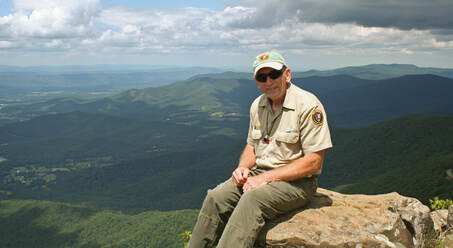 VMN Jack Price. Photo contributed by Jack, taken by one of his friends and used with permission.
VMN Jack Price. Photo contributed by Jack, taken by one of his friends and used with permission.
Old Rag Honors Jack Price – Outstanding Master Naturalist and Founding Chapter Member
–Contributed by Charlene Uhl, VMN-Old Rag Chapter
At our 2022 Annual Meeting the members of the Old Rag chapter honored Jack Price, a founding member of the Old Rag Master Naturalist chapter and its first President. Jack was a member of ORMN’s first class in 2007 and became a charter member of the chapter when it was incorporated in 2008. Jack served as the chapter’s first president. Over his years of service, Jack also served in the capacity of Continuing Education Chair and long-time member of the ORMN Board.
Jack has taught numerous classes for MNs, including how to create wildlife habitat, botany and tree ID classes. He was a regular instructor for our Basic Training Classes and frequently led field trips throughout the Central Piedmont area. He invited members and others to his land which abutted Shenandoah National Park. There they could observe old growth trees, vernal pools, a multitude of birds as well as many other species and other natural environments.
Jack’s contributions were not limited to the local chapter level. He was invited to serve as a local chapter representative on the VMN Steering Committee when it expanded from just state agency reps to include local chapter representatives. Only four chapter rep positions were created. Jack remained on this Steering Committee until his recent move to Georgia.
His one great love is Shenandoah National Park, where he worked on invasive plant removal, manned the visitor center/bookstore at Byrd Visitors Center, and led educational programs and hikes to wildflower meadows. He also served on the SNP Association and was its president from 2010-2013. His extraordinary number of volunteer hours – almost 7,300 hours as of June 2022 – are testament to his dedication to the Park as well as his many other Master Naturalist activities while he was a member of the Old Rag chapter.
The recipient of the Culpeper Soil and Water Conservation District’s 2012 Educator of the Year, Jack continued to play a role in the lives of many Master Naturalists in our chapter. Two long-time ORMN members shared their admiration for Jack’s mentoring and efforts to engage others in the love and protection of the land and nature in Virginia:
Gail Swift:
“Jack was a mentor to so many of us as we started our journey in the world of master naturalists. His love of nature comes through the minute he starts speaking. He is a wonderful presenter – I heard him everywhere from the Front Royal public library to the Culpeper garden club to presentations at the Byrd Center. Yes, I am a stalker of Jack Price presentations. He transformed his own home to a nature preserve and led ORMN field trips there. He and [his wife] Sally have a goal to visit every National Park in the USA.”
Don Hearl
“I worked with him on several projects, including the habitat restoration project at the Town of Washington. Jack was a do’er … I recall early on in the project, when we were clearing debris and invasives from the site, we had to dig up and remove a huge wild cherry that had died. After we excavated the tree using a backhoe, Jack suggested that we plant it as a centerpiece for the main garden. He said it would be a great habitat tree for woodpeckers. I have to say that was the first time I ever helped plant a dead tree, but later, when woodpeckers appeared, Jack’s cherry tree became a focal point for the project. That project was selected as the Virginia Master Naturalist Project of the Year, thanks largely to Jack Price.”
Jack and his wife have moved to Georgia to be close to family – but he will always have a place in our hearts for his many contributions to the Old Rag chapter.
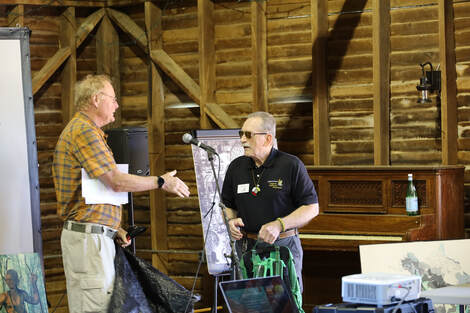
Jack Price receives chapter recognition from VMN-Old Rag Chapter president Barry Buschow. Photo by VMN-Old Rag Chapter.
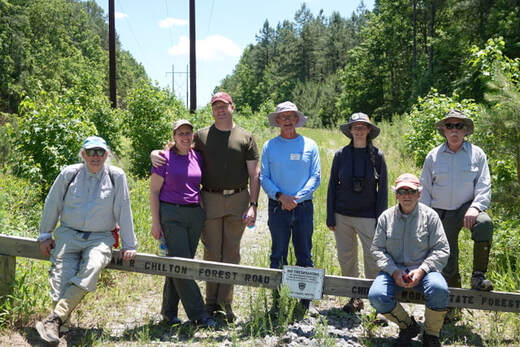 VMN volunteers in the Northern Neck Chapter work at the DOF’s Chilton Woods State Forest on National Trails Day. Photo by Patricia McMurray.
VMN volunteers in the Northern Neck Chapter work at the DOF’s Chilton Woods State Forest on National Trails Day. Photo by Patricia McMurray.
Northern Neck Chapter Stewardship Challenge
–Contributed by Nancy Joel, VMN-Northern Neck Chapter
With the American Hiking Association’s
National Trails Day and the Chesapeake Bay Foundation’s
Clean The Bay Day both being celebrated on June 4 this year, it created a perfect opportunity for stewardship activities to be undertaken by members of the
Northern Neck Chapter. With over 1,200 miles of tidal creeks and streams feeding through the Potomac and Rappahannock Rivers into the lower reaches of the Chesapeake Bay, 22 Department of Wildlife Resources Bird and Wildlife trails in the region, three natural area preserves, two state parks, a state forest, and numerous environmentally important public lands, our members had their choice of a host of opportunities where they could record volunteer hours of stewardship.
In order to muster members to the task, after some discussion, the chapter board came up with the idea of creating a chapter challenge to promote this stewardship opportunity. Initial planning followed all the recognized format with stated objectives, specific organization, and an action plan for completion, but it quickly became apparent that we were overthinking the process, and that it would not take a lot of preplanning for it to be successful. What attracted us most to undertaking the challenge was that our efforts would directly benefit our sponsoring state agencies: Department of Wildlife Resources which oversees the Bird and Wildlife Trails; Department of Forestry which oversees state forests, in our case Chilton Woods, a 397 acre forest in Lancaster County; and Department of Conservation and Recreation which oversees our state parks, Belle Isle and Westmoreland, as well as our Natural Area Preserves, Dameron Marsh, Hickory Hollow, Hughlett Point and Bush Mill Stream.
Wishing to encourage participation, we increased the flexibility of opportunity from just the actual day, June 4, to the week preceding that date and the week following, and ultimately we designated the whole month of June as available to complete the challenge. We also embraced personal preferences by suggesting the stewardship opportunity could be completed by “walking, biking, or kayaking/canoeing”. The original plan did have a challenge goal of 200 volunteer hours, but this was not publicly stated. As our first attempt at a challenge we just wanted to see how the chapter membership responded to the opportunity to participate.
So what did we do? Some members offered to be “site leaders” for our larger natural areas, to help coordinate what, when and how specific stewardship tasks could be undertaken. Some members took responsibility for liaison with the staff of our state parks to ensure our volunteer efforts reflected the parks immediate stewardship needs. Not all our stewardship tasks required brandishing a chain saw. Some required beach and river clean up, as well as signage cleaning, and generally reporting on the condition of trails and byways. Members of the chapter oversee all 22 Department of Wildlife Resources Bird and Wildlife trails in the Northern Neck Loop, and this challenge met their reporting requirement, which includes adding new information to the trail’s online presence about any new flora and fauna present at their site. All this information is collated by our chapter coordinator and sent to the Department of Wildlife Resources. As all the areas available for us to steward have public access, it is an ongoing task to keep them free from trash and debris, and report any conditions that might pose a hazard to seasonal visitors.
One of the planning points we pondered was how to judge whether the challenge was a success and worth repeating in the future. We asked members to report their efforts, and more importantly, make sure they entered their volunteer hours into Better Impact. This latter reminder made the exercise of evaluating success very easy. Working with our membership chair we were able to gather quickly all stewardship volunteer hours relating to trail work and clean up for the month of June, and even though some members may be yet to enter their hours, I can report that we are close to achieving the original challenge target of 200 stewardship volunteer hours. An additional benefit from the challenge was that over half of our recently graduated Basic Training Class members took part in the opportunity and recorded volunteer hours toward their first full certification.
The original invitation to participate is really all it took to get members engaged in the challenge. “Visit your special place” and “just grab the sunscreen and water bottles and go have fun for a good cause” prompted 26 members and counting, to volunteer time to stewardship. Members went out individually, in pairs and in groups, established members took new members to experience places they had not visited before. What started as an idea, met our stated mission as Master Naturalists, of “volunteers providing services dedicated to the beneficial management of natural resources and natural areas within their communities” and will in all probability, become an established event on our chapter’s annual calendar.
As one of our members said of the challenge experience, “There is nothing I enjoy more than being out in the woods, learning, experiencing, sharing ……”
VMN High Knob Chapter Mason Bee Project
–Contributed by Chris Allgyer, VMN-High Knob Chapter
This spring, several
High Knob Master Naturalists worked with Dr. Kate LeCroy on a new study of mason bees. Dr. LeCroy, who led the VMN Mason Bee Project several years ago, is now a postdoctoral research associate at Cornell University in the Entomology department. Her current research is a study of the fungi associated with mason bees, especially the native bees of species
Osmia georgica which were found in Wise County during the 2019 project. The lab at Cornell has developed methods for doing careful research with baby mason bees, where they can supplement their diets as larvae to study impacts on their growth and survival.
Dr. LeCroy came to Wise County in late March to meet with the High Knob volunteers and review the procedures for installing and monitoring the bee hotels. A total of 7 mason bee hotels were installed in the towns of Big Stone Gap, Wise, Pound, and the City of Norton. The hotels needed to be monitored daily so that when nesting activity occurred, the individual sealed nesting tubes could be carefully removed, packaged, and shipped by next day-overnight service to Dr. LeCroy in Ithaca, NY. The nesting tubes were then opened, and the eggs or larvae were separated into groups for the study. The first sealed nests were collected in early April and nesting activity continued for about 7 weeks. Dr. LeCroy plans to share the results of the study later this fall.
Participants in the project: Gena Kiser, Beth Walker, Paxton Allgyer, Chris Allgyer, and Phil Meeks.
Click on the pictures in the gallery below to see the captions to learn more about the project.
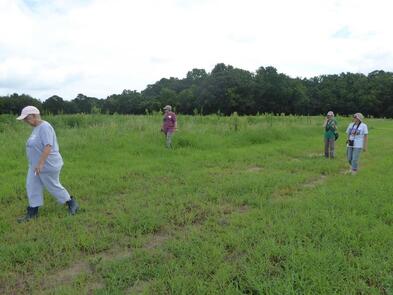 Eastern Shore volunteers survey for butterflies. Photo by Ann Quigley.
Eastern Shore volunteers survey for butterflies. Photo by Ann Quigley.
Laurels to Carolyn Mc Gavock for Organizing Certified Butterfly Counts for the Eastern Shore of Virginia Master Naturalist (ESVMN) Chapter
–Article by Geraldine Baldwin
Since 2018, Carolyn has been working diligently to enable ESVMN Chapter members to join others in providing rigorous data to investigators monitoring butterfly populations. The data provided is an aid for scientific investigators assessing how butterflies may be responding to climatic or other changes to our environments.
Initially, in order to build a cadre of ESVMN members skilled in Butterfly identification, Carolyn encouraged members to participate in the Butterfly Tip Count sponsored by the Coastal Virginia Wildlife Observatory (CVWO). Additionally, Carolyn organized a day of Butterfly counts at each of the Natural Area Preserves on the Shore—i.e., Cape Charles, Savage Neck, Mutton Hunk and Magothy Bay NAPs. In accord with information on the FAQs of the web site of the North American Butterfly Association which conducts counts in the United States, Canada and Mexico, Carolyn divided members into groups including at least one expert in butterfly identification, several spotters and a recorder. The groups used their own Butterfly field guides. Additionally, Carolyn provided lists of possible butterflies obtained from the Delmarva Tip Butterfly count established by the Coastal Virginia Wildlife Observatory over the last 25 years. These counts were carried out in 2018, 2019. In 2020, following pandemic social distancing guidelines, ESVMN members practiced butterfly identification on their own in their yards or other public spaces.
Carolyn envisaged the ESVMN chapter’s contribution would be a new circle count extending the Delmarva Tip count northward on the Shore. Her new circle “North Northampton County” was established following the instructions and guideline of the North American Butterfly Association and is the regulation 15 miles wide. It is centered at Bayside Rd and Sylvan Scene Rd. It abuts the northern most point of the Delmarva Tip circle and encompasses environmentally important conservation areas of Savage Neck NAP and the Brownsville Nature Conservancy Property.
On August 15, 2021 Carolyn lead the first official count on the North Northampton County Butterfly circle. ESVMN members in 4 groups of identifiers, spotters and recorders spread out over the circle in various pre-set locations and counted 34 species of butterflies and skippers for a total of 639 butterflies. 19 volunteers spent over 100 man hours and walked a total of 10 miles to collect the data for this count.
Carolyn’s long term goals include more circles—marching up the Eastern Shore and including Accomack County as well as Northampton County. This year Butterflies will be counted on August 7, 2022 in the Northampton County Circle beginning at 10 AM.
All the data obtained from the North Northampton County Circle was forwarded to the North American Butterfly Association (an all -volunteer organization). The Association’s compilation is an important source of rigorous scientific information in monitoring butterflies of the US, Canada and Mexico. As we all know Butterflies are not only important helpful pollinators for lots of native plants, but also their eggs and larvae are an essential part of the food chain for birds and other animals. Their myriad colors and delicate flitting around add so much beauty for all who encounter them. Monitoring populations of these delicate creatures is especially crucial as they may well be an example of the “canary in the coal mine” as climate and other changes are made in our environments.
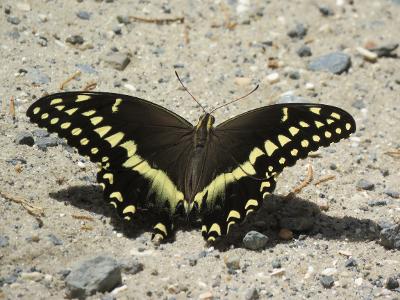
Palamedes swallowtail – Papilio palamedes. Photo by VMN-Eastern Shore Chapter.
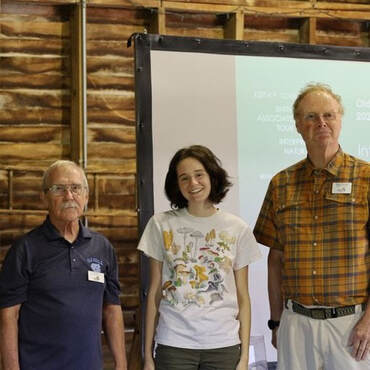 Scholarship winner Hannah Kauffman (center) with VMN-Old Rag Chapter leaders Bill Clark (left) and Barry Buschow (right). Photo by VMN-Old Rag Chapter.
Scholarship winner Hannah Kauffman (center) with VMN-Old Rag Chapter leaders Bill Clark (left) and Barry Buschow (right). Photo by VMN-Old Rag Chapter.
Old Rag Chapter Creates a High School Academic Scholarship Program
–Contributed by Charlene Uhl, VMN-Old Rag Chapter
The
Old Rag chapter recently created a scholarship program for seniors who are attending high school in the chapter’s six-county catchment area. The chapter voted to invite students to apply for a college scholarship that can be used for any expenses associated with college attendance. The scholarship will target students who will be pursuing a degree in natural sciences. Funds were allocated for the award in the FY2022 budget.
Our first scholarship winner was Hannah J. Kauffman from Fauquier High School, who received her award from ORMN Vice President Tom Drier, at the Fauquier High School Awards Night on April 23, 2022. She was honored with a check for a $1,000 at ORMN’s Annual Meeting on June 18, 2022. Hannah thanked the Old Rag members and shared her acceptance to the University of Maine, where she intends to pursue a Bachelors in Marine Biology. She is pictured with Bill Clark, Chairman of the Scholarship Committee and Barry Buschow, President of the Old Rag chapter.
The Old Rag Board of Directors is in the process of creating a standing committee, to be chaired by the Vice President, to oversee the scholarship award in the future. The scholarship fund currently has a total of $3,465, of which $1,465 donated in 2021-2022 by individual members.
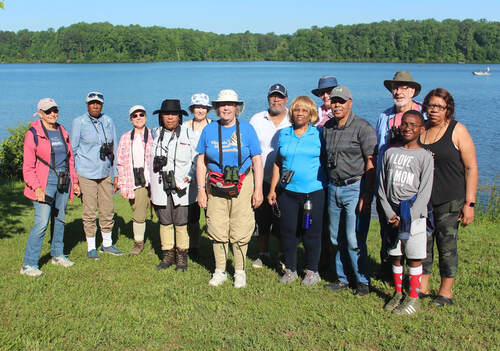 Bird walk participants at Beaverdam Park. Photo by Susan Walton.
Bird walk participants at Beaverdam Park. Photo by Susan Walton. 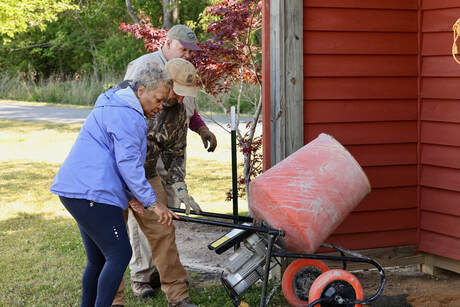 Every project starts with a good foundation. VMN volunteers Henry McBurney and Ken Dugan, and the president of the IOW NAACP Valarie Butler work together on the rainwater retention system project. Photographer: Karen Barlow.
Every project starts with a good foundation. VMN volunteers Henry McBurney and Ken Dugan, and the president of the IOW NAACP Valarie Butler work together on the rainwater retention system project. Photographer: Karen Barlow.
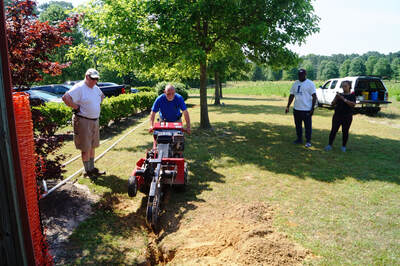 Trenching for the pipe installation Persons in photo: Henry McBurney and Ariane & Aston Williams watching Smithfield town council member Wayne Hall operate the ditch witch. Photographer: John Bunch.
Trenching for the pipe installation Persons in photo: Henry McBurney and Ariane & Aston Williams watching Smithfield town council member Wayne Hall operate the ditch witch. Photographer: John Bunch.

